In this article:
A headache is the sensation of pain, tightness, heaviness, or discomfort in the skull, temples, forehead, and face down to the neck. The extent and intensity of the pain can vary from person to person.
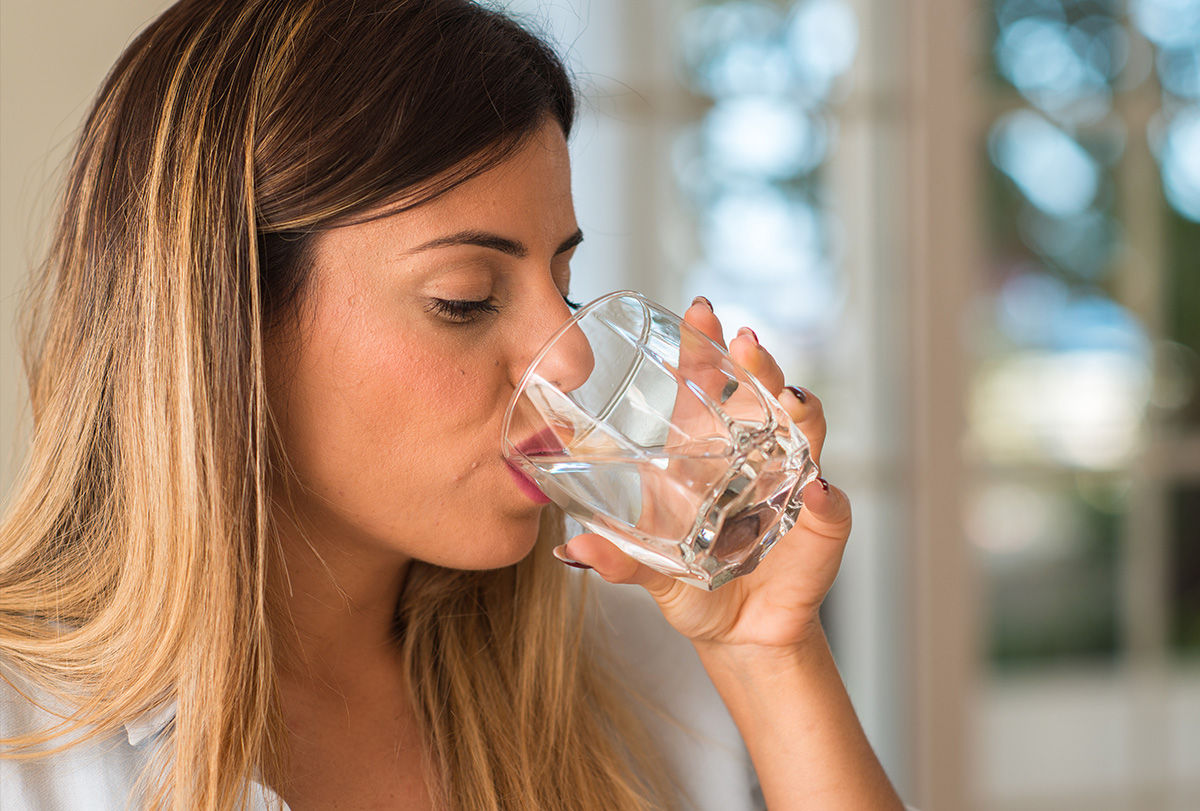
Although headaches are fairly common and affect people of all ages and genders, some people get them more often than others. Generally, there is no single cause behind a headache but multiple factors that act on the pain receptors in your head or neck region.
Home Remedies for Headaches
The following home remedies may help relieve different types of headaches when used, along with standard medications. These interventions cannot eliminate the need for pain meds but make you less dependent on them.
1. Apply an ice pack to your neck
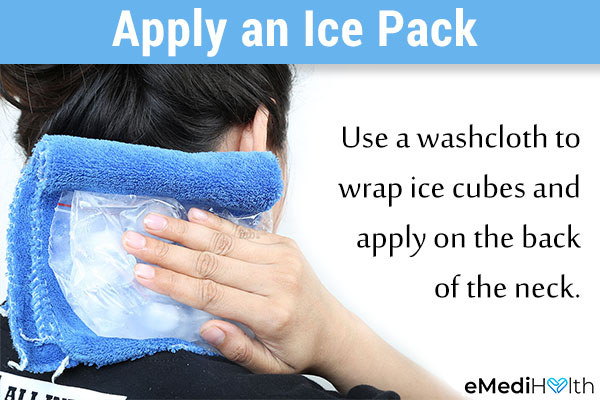
Headaches are often triggered by an underlying inflammation, which can be brought down by applying an ice pack. The cold temperature will temporarily numb the nerve endings in the area of application and make you feel less pain.
A study reported the effective use of a frozen neck wrap for alleviating migraine headaches. (1) But for this therapy to work without causing any undue side effects, you must do it correctly.
How to use:
- Wrap ice cubes in a washcloth and apply it to the back of the neck.
- Alternatively, dip a washcloth in ice-cold water and place it on your head for 5 minutes.
- You can also use a packet of frozen vegetables instead of an ice pack.
An ice pack is a home remedy that can be used alongside the prescribed medications and treatment, rather than as a substitute.
A cold compress can help curb inflammation, which is usually the source of headaches, and relieve the pain, and desensitize the treated area.
2. Consume ginger
Ginger has been used to treat migraine headaches as it has prophylactic and abortive properties.
A clinical trial demonstrated the effective use of ginger for migraine treatment. Therefore, the use of ginger as an adjunct to nonsteroidal anti-inflammatory drugs for migraine treatment can be considered. (2)
How to use:
- Mix 2–3 drops of ginger oil in a carrier oil and gently rub it over your forehead, and nape of the neck two times a day for migraine relief.
- You can also drink 1 or 2 cups of ginger tea a day to ease your headache. Simply boil 1 cup of chopped/grated ginger in 2 to 4 cups of water in a saucepan, filter the tea in a cup, sweeten it with some sugar or honey, and then drink it while hot.
Ginger is an anti-inflammatory agent that acts on the blood vessels in the head, thus helping alleviate a headache.
3. Use essential oils
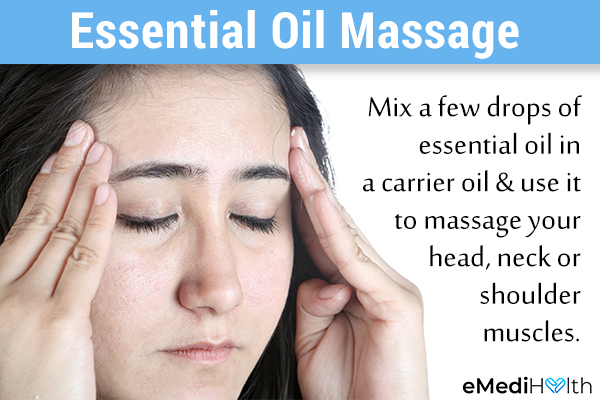
The use of lavender, rosemary, rose, and basil essential oils help in alleviating headaches. The scent of lavender essential oils can help to alleviate tension headaches. The use of lavender oil has been found to be safe and effective against migraine headaches.
In one study, patients registered a reduction in pain and symptoms associated with migraines 15 minutes after inhalation of lavender oil. The oil was rubbed onto their upper lips in the initial phases of the attack. (3)(4)
The menthol in peppermint helps to relieve headaches that are caused by the constriction of blood vessels, such as tension or stress headaches. Menthol dilates the blood vessels and also has pain-relieving properties.
A study showed that a 10% peppermint oil solution prepared using ethanol can be used for the treatment of tension headaches in individuals older than 6 years. (5)
How to use:
Mix a few drops of essential oil in a carrier oil and use it to massage your head, neck, or shoulder muscles.
Note: Oral consumption of essential oils should be avoided. Before using essential oils, check for possible allergies. People suffering from high blood pressure and epilepsy should avoid the use of rosemary oils.
Most essential oils have analgesic and anti-inflammatory properties that can help in relieving headaches when applied topically.
4. Increase your magnesium intake
It is necessary to include magnesium in your diet if you suffer from frequent migraine headaches. One study reported a link between low levels of magnesium and chronic diseases such as migraine. (6)
Research has shown that the use of magnesium is an effective and safe preventive measure against migraines. It may also be helpful in relieving primary headaches. (7) Another study showed that around 50% of patients with migraine had a magnesium deficiency. (7)
Magnesium, available in oral and intravenous forms, is highly useful for magnesium-deficient patients. Thus, preliminary treatment with oral magnesium is recommended for people suffering from migraines.
How to use:
- Eat magnesium-rich foods.
- Consult your doctor about the appropriate dosage before staring magnesium supplements.
Magnesium is known to reduce pain perception during a migraine attack by obstructing the activity of certain neurotransmitters.
5. Increase your water intake
Headaches can commonly result from dehydration. (8) Dehydration occurs due to less fluid intake or excessive fluid loss, resulting in decreased body water content. Constant thirst, dryness in the mouth, and lethargy are symptomatic of dehydration. (9)(10)
How to use:
- Drink water, oral rehydration solution (ORS), or coconut water in small sips throughout the day. You can also consume water-rich foods.
- Avoid drinking alcohol (11) or carbonated drinks, (12) as they promote dehydration.
To relieve a headache caused by dehydration, you need to increase your intake of fluids.
6. Apply a hot compress
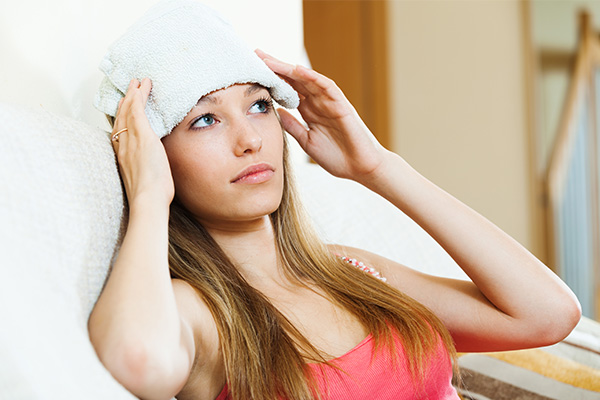
The application of gentle heat can help stimulate blood circulation and relax the tense muscles in the area. Both of these therapeutic effects can play a significant role in relieving headaches. However, you have to be careful whenever using heat therapy to avoid burns.
How to use:
- For tension headaches, place a hot compress on your forehead or the back on your neck to loosen the knotted muscles in this area. (13)
- Soak your feet in hot water to help your head feel better. By drawing blood to your feet, the hot-water footbath will ease pressure on the blood vessels in your head. For a really bad headache, add a bit of hot mustard powder to the water.
7. Consume caffeine
Caffeine reduces blood vessel swelling and thus, can help relieve a headache. This is why caffeine is an ingredient in some extra-strength painkillers. (14)
Note that caffeine withdrawal can cause headaches, creating a vicious cycle, so you must consult your doctor about the proper way of using this remedy.
How to use:
Generally, the recommended intake is between 200 mg and 300 mg a day, which is no more than 3 cups. But your doctor will review your overall health to suggest the appropriate amount for you.
Note: Excessive caffeine intake can adversely interact with certain medications and supplements and increase the risk of heart ailments. Thus, you must consume caffeine in moderation to maximize its benefits while avoiding its risks.
8. Consume butterbur products
There is currently no cure for migraines but the best you can do manage them by identifying and avoiding triggers, which is often quite difficult.
When all other tools fail, you can take butterbur supplements. Butterbur is a medicinal herb that has proven quite effective in managing migraines both in children and adults.
Most migraine specialists recommend this medicine to their patients, which points to its safety and efficacy. (15)(16)
How to use:
The prescribed dosage of butterbur supplements is 75 mg taken two times a day for the first month, which is then tapered down to 50 mg twice a day.
Note: Consult your doctor before taking butterbur supplements to determine the correct dosage and safety of the brand. Also, some butterbur products contain harmful chemicals called pyrrolizidine alkaloids (PAs) that can induce lung or liver damage, hamper your blood flow, and cause cancer. Thus, make sure your product is labeled PA-free before using it.
9. Take vitamin B complex
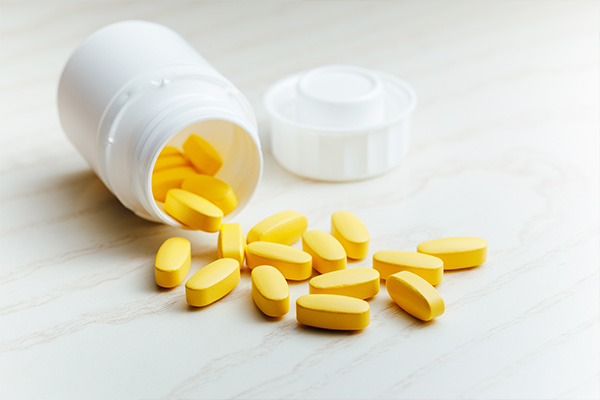
There are eight types of B vitamins, some of which have been found useful in reducing the severity and incidence of headaches. These include riboflavin (B2), folate (B9), cobalamin (B12), and pyridoxine (B6). (17)
You can get your required dosage of these vital nutrients through your diet or oral supplementation. B complex vitamins contain the necessary amounts of all the B vitamins and are available in pill form at most pharmacies.
Ask your doctor about the appropriate dosage before starting this supplement, which has proven to be quite a safe and inexpensive treatment for headaches.
How to use:
Daily doses of 400 to 500 mg of vitamin B2 may help prevent migraines in some people.
Note: Consult your doctor before consuming any supplements.
10. Consume or inhale apple cider vinegar
Apple cider vinegar (ACV) is yet another anecdotal remedy for headaches, especially those triggered by poorly regulated blood sugar or sinus problems. This mildly acidic liquid has been credited with a lot of therapeutic potential but there isn’t any solid scientific evidence to substantiate these claims.
Nevertheless, a lot of general users have reported positive results after using this remedy with little to no side effects, if used correctly.
How to use:
- Mix 2 teaspoons of ACV in a glass of water, and add some honey and lemon juice to it for better taste. Drink this tonic thrice a day for headache relief.
- Take equal amounts of water and ACV in a pot and bring this mixture to a boil. Then, breathe in the therapeutic vapors to relieve sinus headaches.
Note: ACV can erode the tooth enamel, which is why it’s important to drink this tonic through a straw and rinse your mouth thereafter.
Alternative Treatment for Headaches
Acupressure is a complementary therapy that can make your headaches less intense or less frequent, but it must only be performed by a specialist.
Acupressure involves the application of pressure to specific points of the body, known as acupoints. This technique is part of traditional Chinese medicine. Acupressure helps in releasing muscle tension and enhances blood circulation, thus helping in relieving pain and other problems.
One study demonstrated the effective use of acupressure to relieve chronic headaches. (18)(19) Consult an expert for acupressure therapy.
Living With Headaches: Self-Care Measures
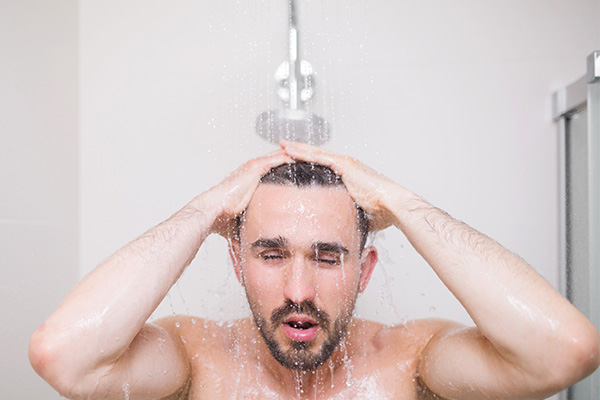
Making changes in your daily routine can help in the management of headaches. Some measures that can be taken include the following:
- Get adequate rest and sleep for 6–7 hours to avoid sleep deprivation.
- Take a bath with warm water.
- Avoid things that trigger your headache. These may include some drinks, such as red wine, or foods, such as dried fruits with sulfates or certain cheeses.
- Do not stay hungry. Avoid fasting and eat at regular intervals.
- Sleep comfortably. Change your bedding or sleeping position if needed.
- Maintain good posture at all times.
- Do not strain your eyes. Get an eye checkup and wear prescription glasses if required.
- Practice meditation to help reduce the incidence of headaches.
- Exercise regularly. This helps in stress reduction and releases endorphins (your body’s natural pain killers). Exercising also helps you obtain good-quality sleep. (20)(21)
- Use a mouth guard if you grind your teeth.
- Avoid alcohol consumption.
- Practice biofeedback techniques, such as abdominal breathing.
- Use heat therapy to manage tension headaches. It may also be used for migraine attacks. However, heat may be a headache-trigger for some.
- Practice yoga as it helps in alleviating the symptoms of migraine. A study compared patients with migraine using conventional care versus conventional care plus yoga 5 days a week for 6 weeks. The group that used conventional migraine treatments plus yoga experienced fewer migraine headaches and less severe headaches when they did occur. (22)
Most-Asked Questions About Headaches
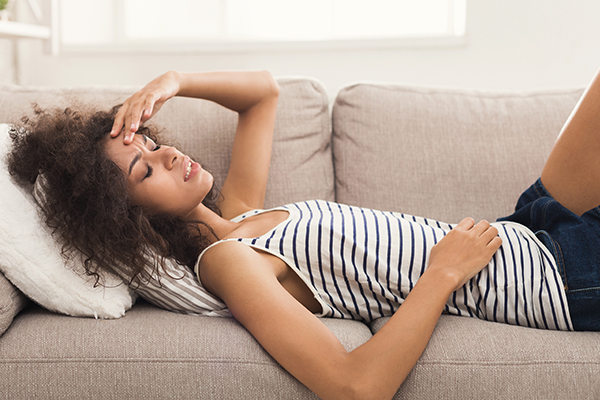
What is occipital neuralgia?
Inflammation or injury in the occipital nerves can cause severe headaches. This condition is called occipital neuralgia.
The occipital nerves run from the top of the spinal cord to the scalp. Occipital neuralgia produces a throbbing, chronic pain, which may occur at the back of the head, around the ears, or in the upper neck.
Can menstruation cause a headache?
A change in hormone levels can trigger headaches. The levels of estrogen and progesterone change before your periods, causing headaches. This is more prominent in women who complain of a migraine.
The headache may be accompanied by joint pain, acne, and fatigue.
Is there a link between a ketogenic diet and headaches?
A keto diet works by reducing the amount of carbohydrates that you consume in a day.
The sudden switch from using starch as an energy source to utilizing the fat stored in your body requires adjustment. This transition period may be associated with a headache.
Headaches caused by a keto diet may last for 1 day to 1 week. If your headache does not subside after that, consult your doctor.
Why headache accompanied by stomach ache occurs?
A headache and stomach ache may occur together due to various reasons. These include infections in the stomach, gastroenteritis (stomach flu), abdominal migraine, kidney diseases, and even excessive alcohol intake.
To find the underlying cause of the headache, the following tests are done based on the information you provide your doctor:
- Sinus X-rays
- Blood tests
- Magnetic resonance imaging (MRI)
- Computed tomography scan (CT scan)
Final Word
Headaches usually resolve on their own and do not require medical attention. But if the condition becomes increasingly frequent such that you get three or more headaches a month, you should seek preventative treatment from a doctor.
OTC medications and lifestyle changes such as staying hydrated and taking proper rest can help relieve occasional headaches, but chronic ones can be the result of serious underlying disorders that require a specific treatment plan.

- Was this article helpful?
- YES, THANKS!NOT REALLY


